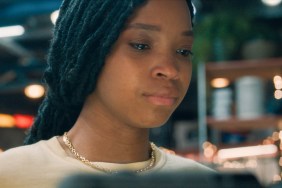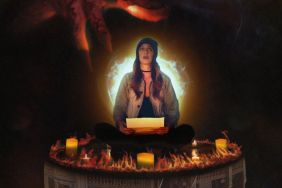
The film is the birthchild of The Exorcism of Emily Rose‘s director Scott Derrickson and C. Robert Cargill, the man known as “Massawyrm,” a movie critic from Ain’t It Cool News. Under Blumhouse Productions – the company that gave us the Paranormal Activity series and Insidious – Derrickson and Cargill collaborated on this effective slice of scare cinema which concerns a writer (Hawke) who discovers a box of Super 8 film in his basement and the creepiness that ensues.
ShockTillYouDrop.com met with the duo in Austin, Texas during Fantastic Fest where we discussed the film’s origins, how Derrickson and Cargill’s creative partnership came about, their feelings on modern horror and where the look of the film’s bogeyman came from.
Shock Till You Drop: How did you two first meet up?
Scott Derrickson: We first met because I had been reading his reviews for years. He was my favorite reviewer for a long time and I never e-mailed him or made contact. The thing about Cargill is I almost always agree with his reviews and when he likes something a lot of people didn’t like, I went to see it and always liked it. When he didn’t like something a lot of people like, I found myself agreeing with that, too. He wrote this rave review of [William Friedkin’s] Bug, which I wasn’t planning on seeing based on the reviews, and I loved it. So, I e-mailed him and thanked him for all of his reviews over the years and that’s how we started talking. Later, we ran into one another in Las Vegas and he pitched the beginning, middle and end of the movie.
Shock: And, Cargill, you were nurturing a screenwriting career in addition to writing reviews?
C. Robert Cargill: No, I wasn’t working as a screenwriter. This was the first time I ever tried to actively make a movie. I was a critic a long time. For two years before this, I was working on a novel which got picked up and is coming out through Harper Collins in February.

Shock: Now, did the story come out of any frustration or celebration of what you hate or love about the genre? A response to something in particular?
Derrickson: Yeah, we probably had different things that motivated us in that respect. For me, when I heard Cargill’s concept for the movie, as a director, what immediately struck me was that it was something that could be sold as having some value in the found footage genre which is the only thing anybody seems to be making these days. What I’ve grown tired of in that genre is how uncinmatic the films are. That there’s no cinematography or effort for unique and striking imagery. There’s very little sound design, there is no score sometimes. And those are elements of cinema I like, especially in horror. So, being able to do a movie that centers around found footage – and the guy who finds that footage – and introduce those cinematic qualities was a big part of the appeal.
Cargill: This, for me, was a reaction to what I was seeing in horror. Since Blair Witch, found footage has a been a thing. For most people, they feel found footage went from Blair Witch to Paranormal Activity. Those were the two, but you know, as a critic, we’ve been seeing them for years. And every time I’ve watched one, I thought, “What was it like to actually find this footage?” And what happens when somebody discovers something attached to the paranormal, what’s that story? The evolution of this story came out of this notion. Also, almost all of our movies here in the U.S. have happy endings. I hate the fact that the classic ’70s and ’80s ending, the one that leaves you horrified, doesn’t often happen now. You get that in Paranormal Activity and those films, but you don’t get that in the traditional horror movies. I wanted to see something where the ending pays off and you earn it. In most U.S. horror movies, they get out of danger just in time, but that’s not very scary at all. This movie was very much a reaction of what’s been going on.
Shock: The footage that is indeed found in the film is quite disturbing. Did anyone higher up in the producing ranks have a problem with this and ask to tone it back? Or maybe the distributor?
Derrickson: They bought the script so they knew what was there. Because the movie was inexpensive, I think it was a safe bet for them. But where they hedged their bet is that they commited to a limited release, not a wide release. But if the movie scored over a 65 in a test screening – which isn’t that high…

Cargill: For a horror movie it is. The average horror movie scores at about a 50.
Derrickson: They said if we scored around 65, we’d get a wide release and we scored in the 80s so they were just elated. It’s just proof that the popular audience, those in these test screenings, can handle the darker, edgier, more dangerous stuff. They like it because it’s fresh. And I think the studios get more nervous than they should when it comes to the genre.
Cargill: I will say, in this case, though, both the financiers and our producers sent us notes but they were never about toning it down, it was about making it scarier.
Shock: You mentioned that everyone read the script so they knew what they were getting into, but you know – tonally – things can get darker than what’s on the page.
Cargill: And it did. We wrote a PG-13 script. And, in the script, it’s PG-13, but what we put on the screen is something the MPAA said, “No, that’s an R-rated movie.” There’s no gore, no nudity, a PG-13 allotment of swearing – which wasn’t on the page.
Derrickson: The rating we got was for “disturbing images and terror.” [laughs] But what was great, too, neither Summit nor Alliance came back to ask us and scale it back. The only way to get a PG-13 was to make it less scary and they didn’t want to do that. It was never a conversation.
Shock: Did you go through several designs for the look of “Mr. Boogie”?
Cargill: Conceptually, we did. In the script phase, I had described him as a Willy Wonka meets Marilyn Manson. That’s how he was in my head. But I was very fluid about that, because I’m not a visual guy, I’m a story guy. So, I handed that to Scott and once Scott’s process took over there was never a point in which we had Boogie and then changed it.

For Edward Douglas’ thoughts on the film, check out this review.
Stay up to date with the latest horror news by “liking” Shock Till You Drop’s Facebook page and following us on Twitter!









